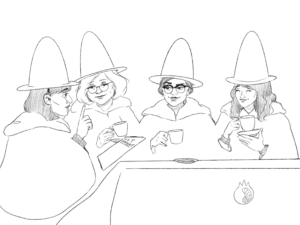Disclaimer: Twin Peeks is a recap/review series about the new season of Twin Peaks — which means there are gonna be spoilers here for everything old and new. If you’re not caught up yet, please do yourself a favor and at least consider it before reading this. If not, you’ll be pretty lost, and you need to get your bearings before diving in. Trust me on this one.
Back in May my boyfriend and I sat down to watch the first two parts of The Return and stared in wonder at the TV screen. We were so in awe that this improbable revival was happening at all, the whole evening almost felt like a dream. In its own way, Twin Peaks has been the dream of David Lynch and Mark Frost from the beginning, taking us to places wonderful, strange, and sometimes disturbing over nearly three decades. Now, after last week’s two-part finale, the dream is over and in true Lynchian fashion, there are even more questions that will probably never be answered.
Trying to recap this season has felt futile at times (and especially now), but I’m going to do my best. In Part 16, everything was leading to a big faceoff between the newly reawakened Special Agent Dale Cooper and his horrific doppelgänger, Mr. C. After wandering through the woods and coming across the same place Bobby and company found a few episodes ago, Mr. C is sucked into a wormhole that plops him right in front of the Twin Peaks sheriff’s station. Just like that, the big showdown we’ve been waiting for is off and running.
He’s posing as the real Cooper until a phone call from the actual Dale Cooper to Sheriff Truman (accompanied by the Mitchum Brothers) breaks this facade. After Lucy shoots him, Andy retrieves Freddie (aka, Piledriver Punch Boy), James, and Naido from the cells in the building and brings them in. The room goes dark, and the woodsmen from part 8 are back — digging through Mr. C like they did earlier this season, eventually harvesting an even bigger BOB-orb.
Suddenly the real Cooper is back, and the battle begins — namely, the battle between BOB and Freddie. Punches are thrown and blood is spilled, but ultimately Freddie wins, and the BOB orb is shattered with little to no suspense. This could’ve ended things, but it also happens only 30 minutes into Part 16.

Cooper picks up the Great Northern key from Sheriff Truman, then he looks at Naido and his face becomes superimposed on the screen. Suddenly, Naido’s face opens, revealing the Black Lodge and finally, Diane (!!). They kiss, and I’ll admit that in a largely unpredictable season, it was really nice to see one theory come true in the end (however, it continued Lynch’s tendency to put characters of color on the margins of his work). Cooper goes on to utter “the ancient phrase” — “We all live inside a dream.” He says that he hopes to see all of them again, but that some things will change.
Suddenly the room goes dark, and before we know it, we’re following Diane, Cooper, and Gordon through the boiler room at the Great Northern where Cooper finds his way to Phillip Jeffries, who then helps him time travel to February 23, 1989 — the night of Laura Palmer’s death.
In a sequence that nearly made me fall out of my bed while watching it, we see footage of James and Laura’s conversation in the woods from Fire Walk With Me, this time coated in black and white. When Laura sees something in the woods, however, it turns out to be Agent Cooper. It looks like Cooper’s decades-long mission to bring closure to the case of Laura Palmer has culminated in this ultimate act of heroism.

When the two meet in the woods, and their hands touch, color floods back into the frame. “Where are we going?” Laura asks. “We’re going home,” Cooper replies. We’re then shown the opening moments of the original pilot, except, there’s no body wrapped in plastic on the shore, and Pete Martell gets to go fishing after all.
If this all seems too good, too neat to be true, you’re right. As Cooper and Laura wander through the woods, Orpheus and Eurydice-style, Laura screams and suddenly disappears. In the Palmer house, Sarah smashes Laura’s senior portrait and the glass shatters.
Cooper’s back in the Black Lodge, where Mike asks him a question from the very beginning of the season: “Is it future, or is it past?” Leland Palmer urges him to “Find Laura.” He then exits the Lodge and finds Diane waiting for him in Glastonbury Grove. Together, they take off on a road trip through the desert, surrounded by sand and power-lines. When they reach a certain point (“Exactly 430 miles”), it seems like they’re going to cross over — to where is unclear. “Kiss me,” Cooper tells Diane. “Once we cross over, it could all be different.” They kiss, and then drive into the unknown.

Night falls, and eventually, they stop at a motel, but once Cooper gets out of the car it’s clear everything is different. Diane sees a doppelgänger of herself creeping around the building, but seems unphased. Cooper and Diane get into their room, and everything gets even more harrowing. “What do we do now?” Diane asks, and Cooper replies (in a very un-Cooper way), “You come over here to me.”
What follows is easily one of the most uncomfortable, and disheartening sex scenes in television history. Having Diane (who turned out to be raped by Cooper’s doppelgänger) have sex with someone who, again looks like Cooper but may not actually be him, is an undeniably cruel decision. My stomach turned as I watched. Add in the fact that the soundtrack for this is The Platters’ “My Prayer,” heavily featured at the end of Part 8, and it’s clear that what’s happening here is very, very wrong.
The next morning, Cooper wakes up alone, seemingly in a different motel in Odessa, Texas. There’s a letter from “Linda,” addressed to a “Richard,” informing him that their relationship is over.
Unphased, he heads out into town, and comes across a “Judy’s Diner.” When he goes inside, he asks about another waitress who works there and her address. It’s all much more gruff and stoic than the usual Cooper M.O. — it’s almost like he’s become a median between Mr. C and the original Cooper, and it’s unsettling to watch. He gets the address and takes off, and who he finds there sets the events of the finale into motion.
When Cooper arrives at the house, a woman named Carrie Page, who has Laura Palmer’s face answers the door. When he asks about Laura Palmer, she’s confused. “I’m not her,” she says. He explains that he wants to bring her to Laura’s home, and eventually, she agrees.

When Cooper goes inside the house to wait for Carrie as she packs, he sees a dead body in the living room. Maybe Laura was saved from her fate in Twin Peaks, but even in this reality, trauma follows her incessantly.
The two then head out for the long drive to where it all began. Driving through the night, mostly in silence, they finally see the iconic Palmer house and get out of the car. Cooper and Laura walk up the steps, knock on the door, and a stranger answers. The stranger turns out to be a woman named Alice Tremond, who bought the house from a Mrs. Chalfont (both names should mean something to Twin Peaks diehards) and she has no idea who Sarah Palmer is. The fact that Mrs. Tremond is played by the real-life owner of the Palmer home, Mary Weber, lends an even greater amount of uncertainty to the scene.
Cooper and Laura walk away, with no answers. The pair pause by their car and Cooper suddenly says, “What year is this?” Laura looks around and up at the Palmer house as a ghostly voice calls out, “Lauuuuuraaaa.” She screams as if suddenly remembering everything about her life in Twin Peaks, and with a pop of electricity, the screen cuts to black. Just like that, it’s over.

I’ve sat with this ending for a few days now, and it feels better than when I initially watched it alone in my room. It may have gutted me on first watch, but it’s an ending that’s totally in line with the themes of David Lynch’s work writ large. There’s the question of different identities and suppression that comes up in the very Lost Highway-esque nighttime scenes with Diane and the attempt to discover one’s identity and come to terms with it a la Mulholland Drive. Lynch announced his retirement from filmmaking a while back, so this feels like a fitting goodbye if it turns out to be his last work.
Throughout the finale, there are other countless references to his past films (that scene in the boiler room of the Great Northern was very close to parts of Inland Empire) and even Twin Peaks’ original run. When it’s all said and done, I don’t think it would’ve worked as well with any other ending. From the beginning, we knew that this season wasn’t striving to answer questions from the original series, but it always stings a little when closure evades you yet again no matter how realistic you’re being.
Over the past five months, the feeling that welled up within me every Sunday never went away. Without fail, I’d be a mix of excitement and dread over the newest episode and without fail, every week took me somewhere wonderful, strange, and sometimes disturbing. I don’t know if I’ll ever feel as excited to dive into a TV show as I have this summer, but I’m ultimately grateful that it happened at all, and I’m especially grateful that I had the opportunity to walk through it with you every week. It’s been a wild ride, but I wouldn’t have had it any other way. I’ll see you in the trees, dear reader.




